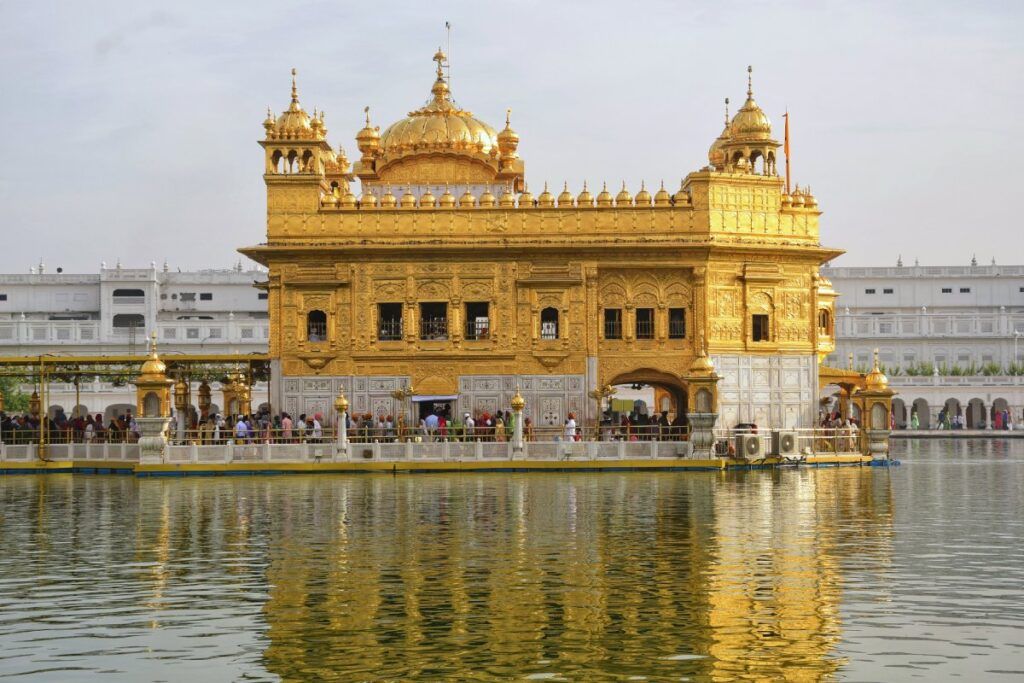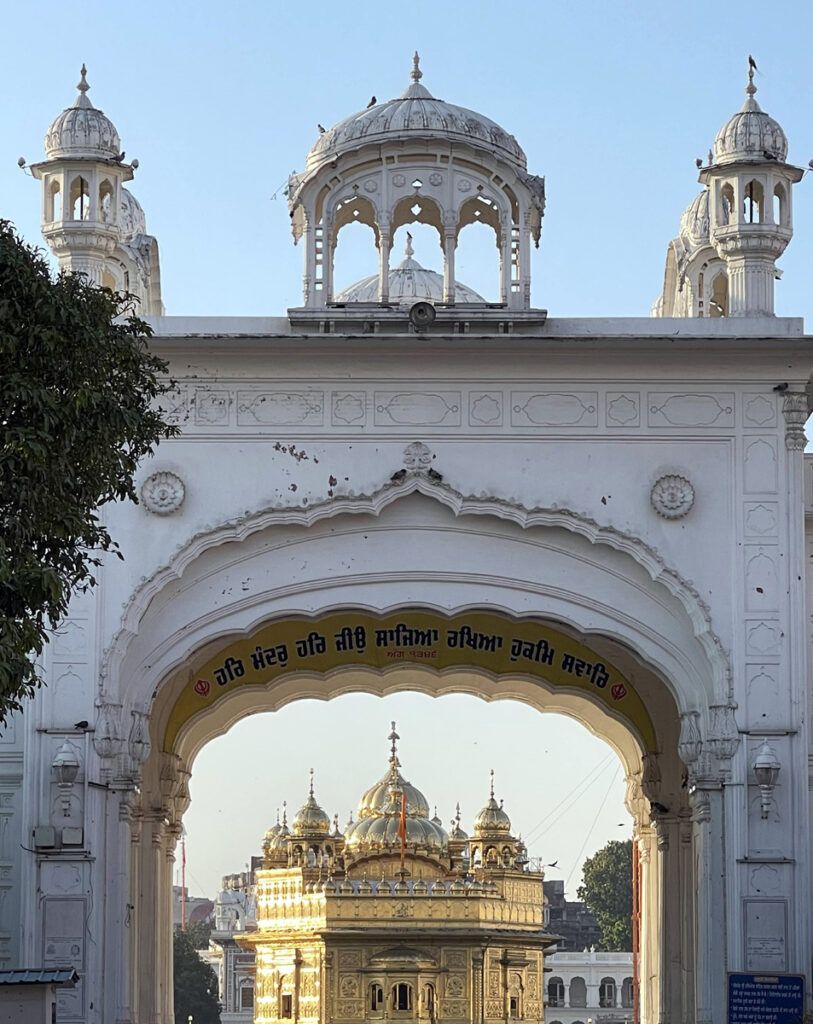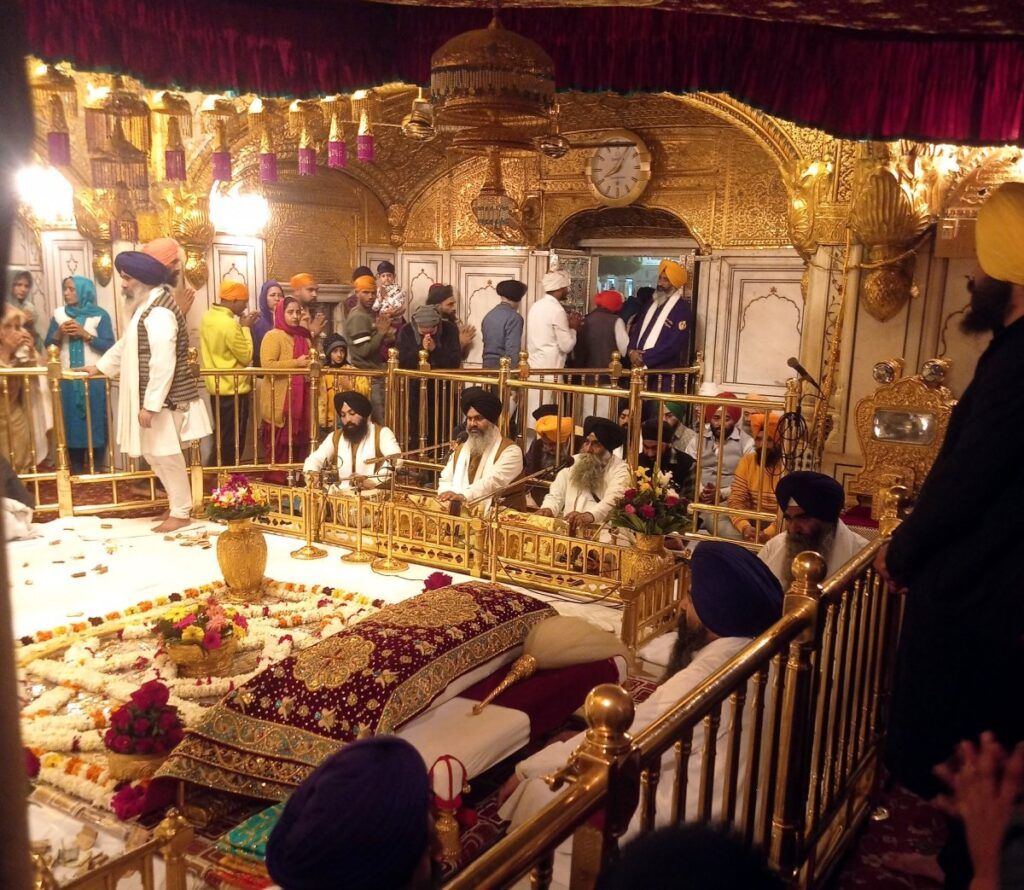Golden Temple, Amritsar (Harmandir Sahib) | Complete Guide
Golden Temple, also known as Harmandir Sahib, is the holiest and most iconic Sikh temple located in Amritsar, Punjab, India. It is a place of immense religious significance and serves as the central spiritual and cultural hub for the Sikh community around the world. The temple is known for its stunning architecture, serene surroundings, and the distinctive golden dome that gives it its name.

Contents
- 1 History and Significance of the Golden Temple:
- 2 Golden Temple architecture:
- 3 Spiritual Practices:
- 4 Visiting the Golden Temple:
- 5 FAQ:
- 5.0.1 What is Sri Harmandir Sahib?
- 5.0.2 What is the history of Sri Harmandir Sahib?
- 5.0.3 What is the significance of Sri Harmandir Sahib?
- 5.0.4 What are the architectural features of Sri Harmandir Sahib?
- 5.0.5 What is the daily routine at Sri Harmandir Sahib?
- 5.0.6 What are the rules and etiquette for visiting Sri Harmandir Sahib?
- 5.0.7 What is the best time to visit Sri Harmandir Sahib?
- 5.0.8 What is the dress code for visiting Sri Harmandir Sahib?
- 5.0.9 Can I take photographs inside Sri Harmandir Sahib?
- 5.0.10 Is there food available at Sri Harmandir Sahib?
- 6 How to reach Golden Temple, Amritsar:
- 7 Google Maps:
History and Significance of the Golden Temple:
The Golden Temple was founded by Guru Ram Das, the fourth Sikh Guru, in the late 16th century. Guru Arjan Dev, the fifth Sikh Guru, completed its construction in 1604.
The temple is built on a platform in the middle of a sacred tank known as the “Amrit Sarovar.” The tank’s waters are considered holy and are believed to have curative properties.
The Golden Temple holds immense spiritual significance for Sikhs. It represents equality, inclusiveness, and the teachings of Sikhism, which emphasize devotion, humility, and selfless service.
Golden Temple architecture:
The temple’s architecture is a blend of Indian and Islamic styles, reflecting the inclusive nature of Sikhism.
The main building is a two-story structure with a golden dome, white marble walls, and intricate artwork. The dome is covered in gold leaf, which gives the temple its distinctive appearance.
The temple has four entrances, symbolizing the idea of welcoming people from all directions and walks of life.
The interior of the temple is adorned with rich marble work, ornate frescoes, and intricate inlay designs.
The Guru Granth Sahib, the holy scripture of Sikhism, is kept inside the temple on a raised platform, covered in fine fabrics and precious metals.
Explore more Temples>> Konark Sun Temple 13th Century Gem

Spiritual Practices:
The Golden Temple is a place of worship, meditation, and reflection for Sikhs and visitors of all backgrounds.
The “Ardas,” a collective prayer, is offered in the temple’s sanctum, followed by the distribution of “prasad” (blessed food) to all visitors.
Langar, the community kitchen, serves free meals to everyone, regardless of caste, religion, or social status. This practice embodies the Sikh principle of seva (selfless service) and equality.
Devotees can also take part in the “kar sewa,” volunteering for various tasks like cooking, cleaning, and serving in the temple complex.
Visiting the Golden Temple:
The Golden Temple is open to people of all faiths and is one of the most visited tourist attractions in India.
Visitors are required to cover their heads, remove their shoes, and wash their feet before entering the temple premises.
The temple complex is a serene and peaceful place for contemplation and spiritual connection.
Explore more Temples>> Badrinath Temple | Badrinarayan Temple

What is special about Golden Temple?
There are several aspects that make the Golden Temple special:
Spiritual Significance: The Golden Temple is the holiest shrine in Sikhism. It serves as the central religious and spiritual hub for Sikhs worldwide. It was founded by Guru Ram Das, the fourth Guru of Sikhism, and completed by Guru Arjan Dev, the fifth Guru.
Architectural Beauty: The Golden Temple’s architecture is a harmonious blend of Indian and Islamic architectural styles. Its stunning golden facade, reflected in the Amrit Sarovar (holy pool), is a sight to behold. The four entrances symbolize the openness of Sikhism towards all people.
Amrit Sarovar (Pool of Nectar): The temple is surrounded by a sacred pool known as the Amrit Sarovar. It’s believed that taking a dip in its waters can have healing and purifying effects. Devotees often immerse themselves in the sarovar as a part of their visit.
Adi Granth and Kirtan: The Guru Granth Sahib, the holy scripture of Sikhism, is considered the eternal Guru. It is placed on a throne within the inner sanctum of the temple. Continuous recitation of Gurbani (hymns) from the Guru Granth Sahib is performed in the temple, creating an atmosphere of spiritual tranquility.
Langar (Community Kitchen): The Golden Temple’s langar is one of its most distinct features. It serves free meals to everyone, regardless of their background, religion, or social status. This embodies the Sikh principles of equality, service, and community.
Global Community: The Golden Temple serves as a unifying force for Sikhs worldwide. Sikhs from all corners of the globe consider visiting the temple as a deeply meaningful and spiritually enriching experience.
History and Resilience: The Golden Temple has a rich history marked by challenges, including the devastating Operation Blue Star in 1984. Despite these difficulties, it stands as a symbol of resilience, faith, and the indomitable spirit of the Sikh community.
Cultural Heritage: Beyond its religious significance, the Golden Temple holds immense cultural importance. It represents the ideals of selfless service, humility, and social equality that are integral to Sikhism.
Peaceful Coexistence: The temple’s inclusive nature welcomes people from all walks of life. It’s a place where people of different faiths and backgrounds can come together in a spirit of unity and peace.
Symbol of Sikh Values: The Golden Temple encapsulates the core values of Sikhism, including humility, compassion, selfless service, and devotion to God. It serves as a living embodiment of Guru Nanak’s teachings.
Explore more Temples>> Swaminarayan Akshardham Temple, Delhi | Complete Guide

Who built the Golden Temple and when?
The foundation of the Golden Temple, also known as Harmandir Sahib, was laid by Guru Ram Das Ji, the fourth Guru of Sikhism, in December 1588. However, the construction of the temple complex was completed under the leadership of Guru Arjan Dev Ji, the fifth Guru of Sikhism.
The temple was designed by Guru Arjan Dev Ji and was intended to serve as a central place of worship for the Sikh community. The construction of the temple complex involved both physical and spiritual dimensions. The work on the temple began around 1589, and it took several years to complete.
The Golden Temple was built in Amritsar, Punjab, India, in the midst of a sacred pool called the Amrit Sarovar. The temple’s construction was completed in 1604, and the Adi Granth, the holy scripture of Sikhism which later became the Guru Granth Sahib, was placed within the temple. This marked the completion of the physical structure as well as the establishment of the spiritual significance of the Golden Temple.
Some notable places near the Golden Temple that you might consider visiting:
Jallianwala Bagh: This historical site is adjacent to the Golden Temple. It commemorates the tragic Jallianwala Bagh massacre that occurred in 1919 during British colonial rule. The site features a memorial and a garden, serving as a reminder of the sacrifices made by the people for India’s independence.
Durgiana Temple: Also known as the Lakshmi Narayan Temple, this Hindu temple is located a short distance from the Golden Temple. It is dedicated to Goddess Durga and houses several other deities. The temple’s architecture is reminiscent of the Golden Temple and is a popular pilgrimage site for Hindus.
Partition Museum: Located near the Golden Temple, this museum commemorates the history of the Partition of India in 1947. It provides insights into the human stories, struggles, and impact of the Partition on individuals and communities.
Maharaja Ranjit Singh Museum: This museum is housed in the Ram Bagh Palace and is dedicated to Maharaja Ranjit Singh, the founder of the Sikh Empire. It displays artifacts, weapons, paintings, and personal belongings of the Maharaja.
Gobindgarh Fort: This historic fort was originally built by Maharaja Ranjit Singh and has recently been restored and opened to the public. It offers insights into the region’s history and features various exhibits, cultural performances, and dining options.
Khalsa College: Established by the Singh Sabha Movement, this college is known for its impressive architecture and historical significance. It houses a museum showcasing Sikh heritage and artifacts.
Central Sikh Museum: Located within the Golden Temple complex, this museum showcases a collection of historical Sikh artifacts, paintings, and manuscripts that provide insights into Sikh history and culture.
Hall Bazaar: A bustling marketplace near the Golden Temple, Hall Bazaar is known for its vibrant atmosphere, shops, and stalls offering various items including handicrafts, textiles, jewelry, and traditional Punjabi cuisine.
Ram Tirth: Situated about 11 kilometers from Amritsar, Ram Tirth is believed to be the birthplace of Lord Rama’s sons, Luv and Kush. The site has a temple and a tank where devotees take a holy dip.
Tarn Taran Sahib: Located about 25 kilometers from Amritsar, this gurdwara is known for its large holy sarovar and its connection to Guru Arjan Dev Ji.

FAQ:
What is Sri Harmandir Sahib?
Sri Harmandir Sahib, also known as the Golden Temple, is the holiest Sikh shrine in the world. It is located in the city of Amritsar, India, and is a popular pilgrimage site for Sikhs and people of all faiths.
What is the history of Sri Harmandir Sahib?
Sri Harmandir Sahib was founded in the 16th century by the fourth Sikh Guru, Guru Ram Das Ji. He envisioned a place where people of all faiths could come together to worship. The temple was completed by the fifth Sikh Guru, Guru Arjan Dev Ji, in 1604.
What is the significance of Sri Harmandir Sahib?
Sri Harmandir Sahib is a symbol of Sikhism’s universal message of love, peace, and equality. It is also a place where people from all walks of life can come together to experience the divine.
What are the architectural features of Sri Harmandir Sahib?
Sri Harmandir Sahib is a beautiful and unique example of Sikh architecture. It is built on a square platform in the middle of a sacred pool, called the Amrit Sarovar. The temple is made of white marble and gold leaf, and is decorated with intricate carvings and mosaics.
What is the daily routine at Sri Harmandir Sahib?
The daily routine at Sri Harmandir Sahib is centered around the worship of the Guru Granth Sahib, the Sikh holy scripture. The Guru Granth Sahib is placed in the central shrine of the temple, and is continuously recited throughout the day. Devotees also come to the temple to pray, meditate, and perform seva, or selfless service.
What are the rules and etiquette for visiting Sri Harmandir Sahib?
Visitors to Sri Harmandir Sahib must cover their heads and feet before entering the temple complex. They must also remove their shoes and deposit them at the shoe counters. Smoking, drinking alcohol, and taking photographs inside the temple are prohibited.
What is the best time to visit Sri Harmandir Sahib?
Sri Harmandir Sahib is open to visitors 24 hours a day, 7 days a week. However, the best time to visit is during the early morning hours, when the temple is less crowded.
What is the dress code for visiting Sri Harmandir Sahib?
Visitors to Sri Harmandir Sahib must cover their heads and feet before entering the temple complex. Men should wear long pants, and women should wear long skirts or dresses.
Can I take photographs inside Sri Harmandir Sahib?
Taking photographs inside Sri Harmandir Sahib is prohibited. However, there are many photographers outside the temple who can take your photograph against the backdrop of the Golden Temple.
Is there food available at Sri Harmandir Sahib?
Yes, there are several langars, or community kitchens, at Sri Harmandir Sahib where visitors can get free food. The langars serve vegetarian food to people of all faiths.
How to reach Golden Temple, Amritsar:
By Air:
The nearest airport to the Golden Temple is Sri Guru Ram Dass Jee International Airport in Amritsar. It’s well-connected to various major cities in India and a few international destinations. From the airport, you can easily find taxis or other transportation options to reach the Golden Temple, which is around 13 kilometers away.
By Train:
Amritsar Junction railway station is well-connected to major cities in India. It’s one of the major railway stations in the region. From the railway station, you can take a short auto-rickshaw or taxi ride to reach the Golden Temple.
By Road:
Amritsar is well-connected by road networks, and you can reach the city by bus or private vehicle. There are state-run buses as well as private operators that connect Amritsar to various cities in Punjab and nearby states. Once in Amritsar, you can easily find auto-rickshaws, cycle-rickshaws, and taxis to reach the Golden Temple.
Local Transportation:
Amritsar has a well-developed local transportation system. Auto-rickshaws, cycle-rickshaws, and taxis are readily available for short distances. You can also use app-based ride-sharing services. Many hotels in the city also provide transportation services for their guests.
Walking Distance:
Depending on your location in Amritsar, you might be able to reach the Golden Temple by walking. Many hotels and accommodations are within walking distance of the temple, especially if you’re staying in the old city area.
Guided Tours:
If you’re a tourist or unfamiliar with the city, joining a guided tour could be a convenient way to reach and explore the Golden Temple. Many tour operators offer guided tours that include transportation, a guide, and insights into the history and significance of the temple.
